Registration opens on September 8th.
Keep an eye on the website and social media!
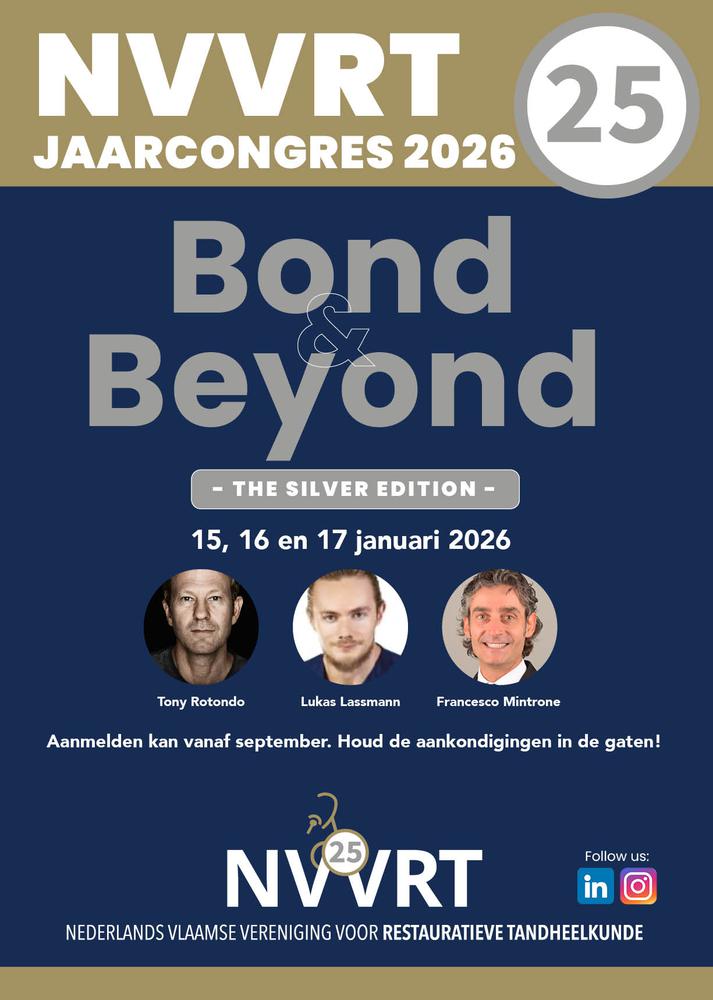
NVVRT Anniversary Congress 2026
The Netherlands-Flemish Association for Restorative Dentistry (NVVRT) will celebrate its fifth anniversary in 2026, marking its 25th anniversary.
And an anniversary means celebrating. That's why next year there will be a congress lasting not one, not two, but three days! You are cordially invited to the annual congress on January 15, 16, and 17, 2026, at the Van der Valk Hotel in Utrecht.
A very promising congress with a wonderful program. The well-known pre-symposium is a must on Thursday, followed by a full day of Tony Rotondo on Friday. The bonus on Saturday consists of several workshops led by Tony Rotondo, Francesco Mintrone, and Lukas Lassmann!
It's unique in the Netherlands to have these three speakers together at one event.
In addition, the NVVRT invites you to celebrate its anniversary with us on Friday evening, January 16th, and to attend a fantastic party.
Program:
Thursday
On Thursday afternoon, January 15, 2026, you are also cordially invited to the Pre-Symposium. During this meeting, various colleagues, dentists, and dental technicians will discuss interesting case studies. This afternoon will be interactive and informal.
Friday
On the conference day, January 16, Tony Rotondo will share his versatile approach, combining restorative treatments with surgery. He advocates for slow dentistry and approaches his treatments from a functional perspective. His excellent results are a testament to his clinical talent and experience.
The lectures will cover planning based on aesthetic outcome and communication with his dental technician, the necessary surgical procedures such as crown lengthening and gingival reconstruction, and working with both ceramic and composite. Interdisciplinary case studies will be presented, and the excellent results demonstrate a beautiful harmony between pink and white aesthetics.
Party Time
On Friday, January 16, there will be a festive evening with dinner for all NVVRT members and conference participants. This celebratory gathering will take place in the exclusive and atmospheric national monument in the heart of Utrecht: the modern and high-tech film studio "De Leeuwenbergh" (Servaasbolwerk 1a, 3512 NK Utrecht).
We’ll kick things off with a welcome drink to reflect on an inspiring day at the conference, followed by a fantastic dinner and a vibrant party featuring a DJ and The Sunny Side Up Band (not your average cover band!). From Michael Jackson to Snoop Dogg, and from the sixties to today – they’ve got it all!
A personal contribution of €100 per person is requested – the rest is covered by NVVRT!
Buses will depart from the conference venue at 6:30 PM, and return transport is also arranged.
If you prefer to travel independently, there are excellent parking options nearby. Utrecht Central Station is within walking distance.
Dress code: Casual festive.
Don’t miss it – it’s going to be an unforgettable night!
Saturday
On the third day, Saturday, January 17th, three workshops will take place. In a smaller group, you will have the opportunity to learn from one of the three grandmasters of your choice: Tony Rotondo, Francesco Mintrone, or Lukas Lassmann.
The workshops will take place from 9:30 AM to 4:30 PM.
9:30 AM – 12:30 PM Workshop with a coffee break
12:30 PM – 1:30 PM Lunch
1:30 PM – 4:30 PM Workshop with a coffee break
Participation in one of the workshops is only possible in combination with a conference ticket for Friday.
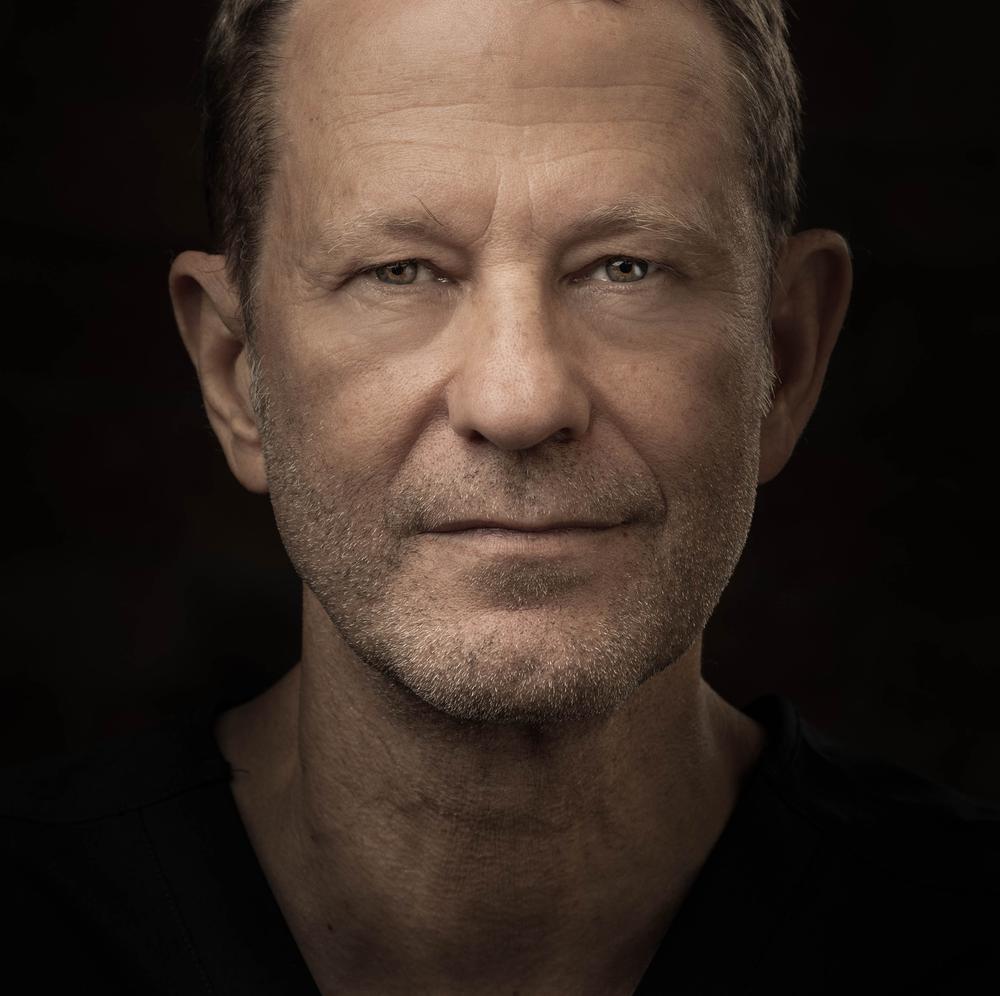
Tony Rotondo
During this workshop, which accommodates 20-25 participants, soft-tissue management and pontic site development in the creation of (etched) bridges in the anterior region will be the focus. The harvesting of a tissue graft, augmenting the recipient site, and shaping it with temporary supports will be discussed. Of course, the necessary and associated suturing techniques will also be covered. In short, a restorative-surgical workshop for optimal aesthetic results!
Franceso Mintrone
In this restorative-digital workshop, Francesco Mintrone will discuss planning rehabilitations using a digital workflow, which essentially includes a thorough functional and aesthetic analysis. The differences with an analog workflow will be explained, and you will receive an update on the available materials for such treatments. In addition to restorative dentistry, implantology will also be covered. A hands-on component is, of course, essential: you will get to work with digital planning yourself.
Lukas Lassmann
Lukas Lassmann will address dentition requiring comprehensive rehabilitation, using a reorganizing approach. He believes that participants should always be well-informed about the "why" before addressing the "how," and he will therefore share a considerable amount of knowledge with you in his workshop. Dogmas, controversies, and mystique surrounding TMD and CR will be addressed. He will also address deprogramming, and what relationship and bite height will the patient be rehabilitated to? The above will be discussed primarily using dentition with (severe) wear. This workshop focuses on diagnosis and planning for a functional end result.
Participation in one of the workshops is only possible in combination with a conference ticket for Friday. Number of participants for each workshop is limited en participation is granted in order of registration. Registration starts at September 8th, 20:01h.
Program:
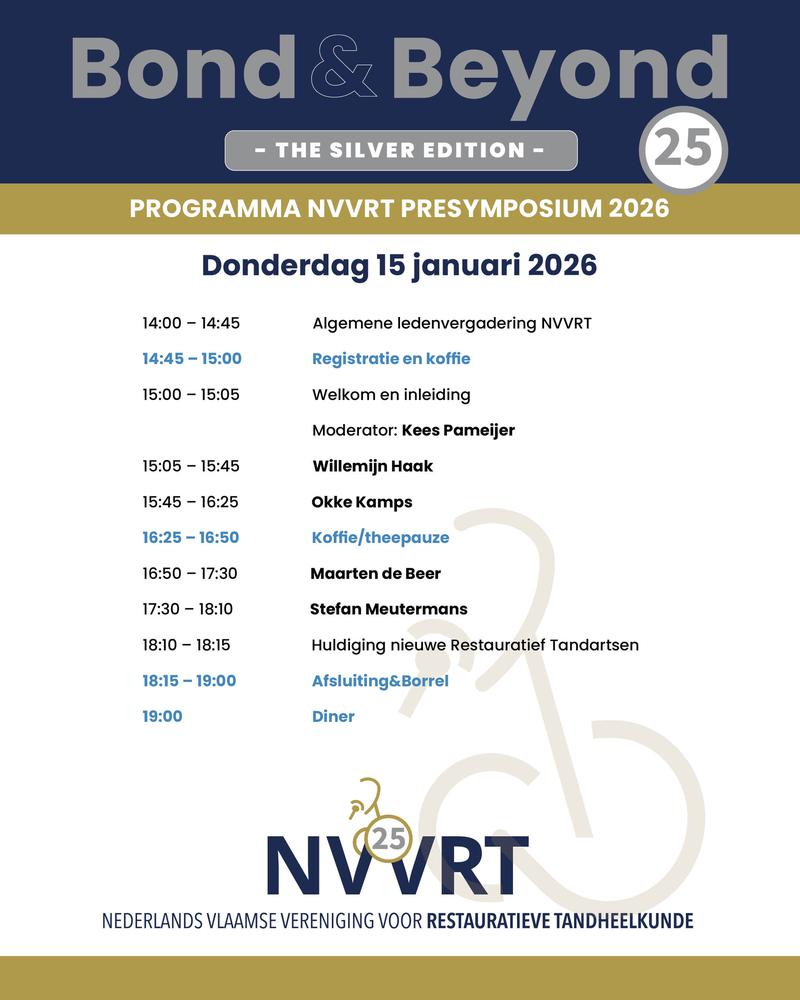
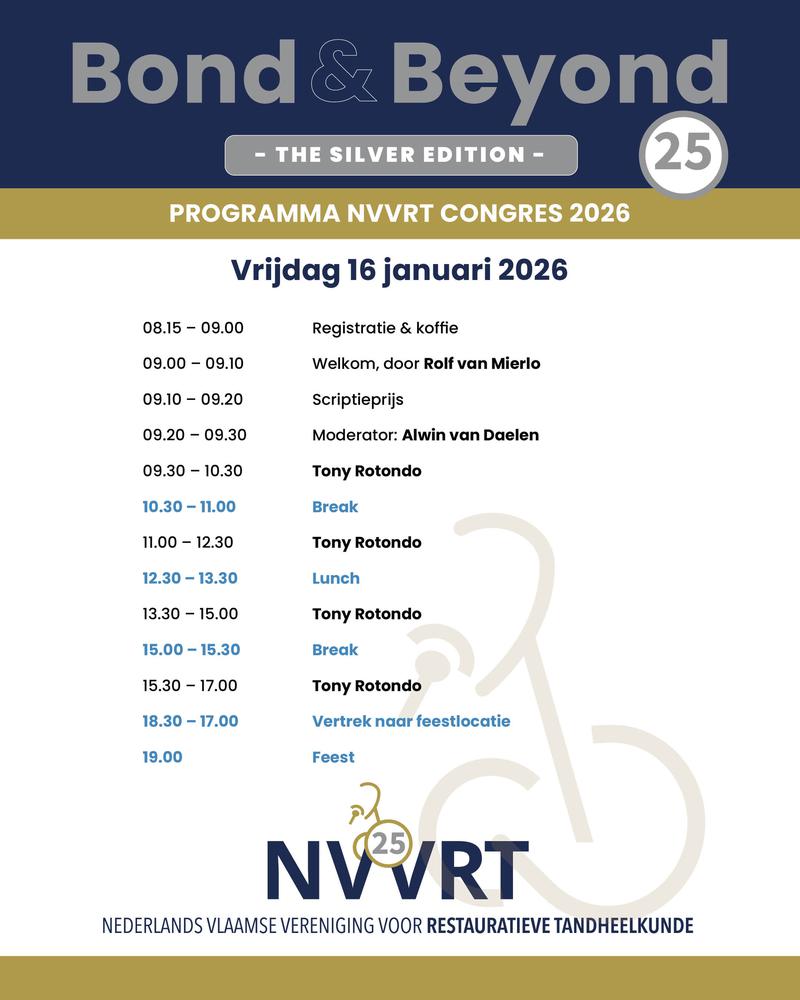
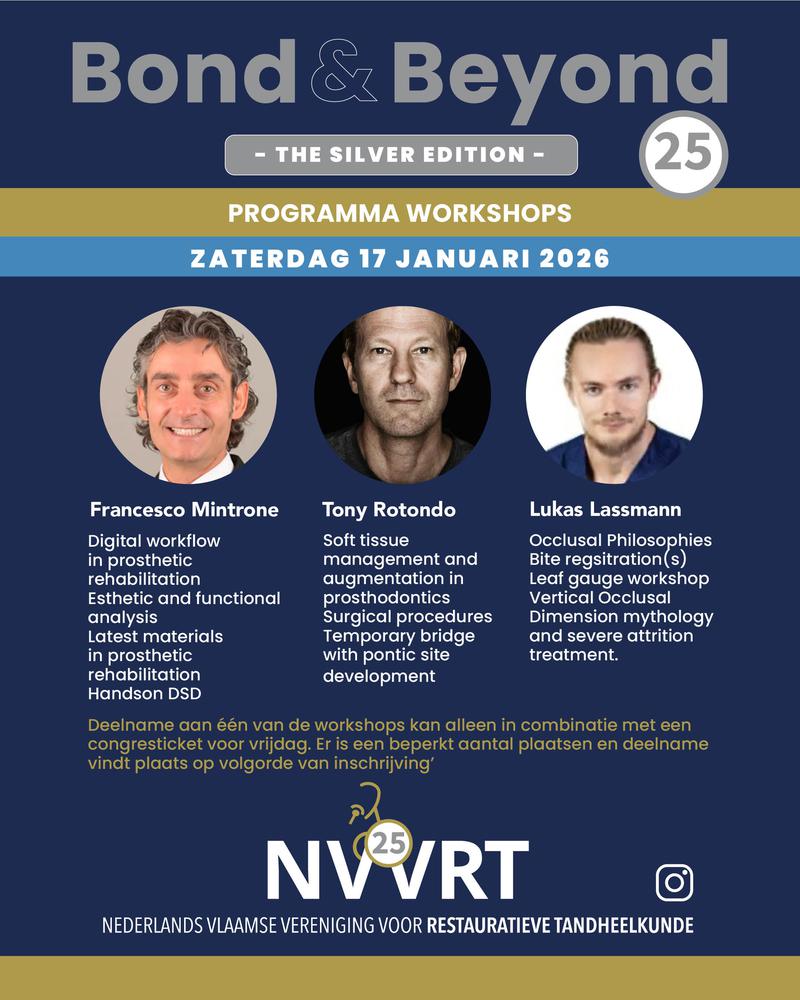
GENERAL INFORMATION
Accreditation
Accreditation is being sought from the Dutch Register of Dentists (KRT).
Conference Language
The conference language on Thursday will be Dutch.
All lectures and workshops on Friday and Saturday will be in English.
Target Audience
The conference is intended for dentists, dental technicians, and dental students.
Location
Van der Valk Hotel Utrecht
Winthontlaan 4
3526 KV Utrecht
www.vandervalkhotelutrecht.nl
Fees: EARLY-BIRD rate, valid up until November 27, 2025
Pre-symposium 100 euros
Dinner Thursday 95 euros
Congress Friday Dentist (member) 495 euros
Dentist (non-member) 595 euros
Dental technician (member) 395 euros
Dental technician (non-member) 495 euros
Student 95 euros
Party and dinner night Friday 100 euros
Workshop Saturday Member&students 550 euros
Non-member 650 euros
Passe-partout: EARLY-BIRD rate, valid up until November 27, 2025
Choose a passe-partout ticket with admission to Thursday, Friday, and Saturday (1 workshop) plus the Thursday dinner and Friday party for an additional anniversary discount of 195 euros. While supplies last!
Passe-partout Dentist (member) 1145 euros
Dentist (non-member) 1345 euros
Dental Technician (member) 1045 euros
Dental Technician (non-member) 1245 euros
Student 695 euros
Registration
Registration at a reduced rate of 100 Euro is possible until November 27, 2025.
Participation includes admission to the conference, coffee/tea, and lunch.
Click on the link below for registration:
https://www.aanmelder.nl/nvvrt2026/subscribe
Registration starts at September 8th, 20:01h. The time is a referral to the year of foundation of the NVVRT, 2001.
Dinner
A dinner will be held on Thursday evening. You must register and pay separately for this dinner. The cost is €95 per person.
Hotel
You can book your hotel reservation with the Van der Valk Utrecht.
https://www.vandervalkhotelutrecht.nl/
Dinner/party location Friday
De Leeuwenbergh
Servaasbolwerk 1a
3512 NK Utrecht
Sponsorship
Are you curious about the many opportunities to connect with your target audience during the NVVRT Congress? We invite you to become a partner in this congress. Contact info@nvvrt.com.
More Information
For questions or more information, please contact B.E.N.G. Events and Congresses at nvvrt@bengonline.nl
Sprekers & CV's
Tony Rotondo
CV Tony Rotondo
Tony Rotondo graduated as a dentist in 1984 from the University of Queensland and completed specialty training in Prosthodontics in 1996 at the University of California, Los Angeles (UCLA). Tony is a registered prosthodontist and practices in Brisbane. Tony has a specific interest in aesthetic dentistry, reconstructive dentistry and implant dentistry. Over many years he has developed a reputation within the dental industry as someone who practices at the very highest level.
He has taught both undergraduate and postgraduate dentists at the University of Queensland and the University of Sydney. Tony prolifically presents continuing educational programs teaching dentists both nationally and internationally and is regarded as one of our country's best dental educators.
Tony Rotondo was awarded Digital Design Master by Dr. Christian Coachman who is the inventor of DSD. Tony is also one of the founders and directors of CEO Dental, an organisation that provides dental education for practicing dentists.
Lukasz Lassmann
CV Lukasz Lassmann, DDS, MSc, PhD
I consider myself incredibly fortunate—both personally and professionally. Among my siblings, I was the only one to inherit my mother’s passion for dentistry. That passion shaped my life and led me to a career filled with challenges and growth. Fresh out of my internship, I joined a clinic specializing in medical tourism, catering to patients seeking complex full-mouth reconstructions. I knew almost nothing about the field, but my boss, saw potential in me and entrusted me with these intricate cases. In those early days, I performed several full-mouth reconstructions each month, despite my limited knowledge. I didn’t know what centric relation was, had no understanding of the vertical dimension of occlusion (VDO), and had never heard of “deprogramming”.
Years later, I reflected on why I managed to avoid failures at that time. Few recurring patterns stood out. First of all, most of my patients were over 60 years old, an age group with a minimal risk of developing temporomandibular disorders (TMDs). These patients often had heavily restored teeth with extensive amalgam fillings and cracks, so I prepared them all for crowns. I didn’t adjust the VDO—because I didn’t know how. Instead, I worked in maximum intercuspation (MIP) using the simplest method I could devise: I prepared the teeth on one side of the mouth, registered the bite using the unprepared teeth on the other side, and then repeated the process on the opposite side. Two other factors minimized complications. First, most of the crowns I used were monolithic zirconia, which reduced the risk of chipping. Second, I cemented them with glass-ionomer cement, a straightforward option requiring minimal isolation. This approach helped me build confidence during following months—until a colleague asked me a pivotal question: “Would you do this for your daughter?” The answer was obvious: I wouldn’t. So why was I doing full crown preparation for my patients?
The truth is, like millions of dentists worldwide, I simply didn’t know how to do it differently. If I didn’t create space for ceramics with a bur, I would have to increase the VDO, but by how much? How could I register a bite without a reliable MIP reference? What if the patient couldn’t bite consistently? And if I wasn’t prepping for full crowns, but for veneers or onlays, I couldn’t use glass-ionomer cement anymore. I’d need to learn adhesive cementation and master the use of a rubber dam. Life became far more complicated when I decided to practice less invasively.
To learn more, I decided to dedicate my earnings to training, starting with courses in the U.S. at UCLA, UNC and mentorship under John Kois. I eventually dived into conflicting philosophies of occlusion. A Polish mentor once advised me, “In occlusion, you must choose one ‘God.’ If you listen to everyone, you’ll go crazy.” Thankfully, I didn’t take that advice. Instead, I explored every perspective, convinced that success lay in identifying common principles and discarding unnecessary complexity.
Those first three years of obsessive learning coincided with the launch of my own clinic, initially in Poland and later in Norway. Teaching came naturally to me, starting with my team. I discovered a love for creating presentations and a passion for public speaking. Sharing my cases on social media soon garnered attention, leading to invitations to conduct courses both in Poland and internationally. At that time I knew that according to the pyramid of learning, the most effective way to learn is by teaching others. Teaching requires a “helicopter view,” a deeper understanding than is immediately necessary, the ability to handle challenging questions, and a lifelong commitment to staying updated. This was likely the most significant catalyst for my development in prosthodontics. What about temporomandibular disorders (TMD)?
Initially, I avoided treating TMD patients. But at some point, colleagues assumed that if I was altering occlusions, I must know how to treat TMD. I didn’t—but I didn’t want to turn them away either, which pushed me to learn more. Having more knowledge eventually resulted in even more patients that weren’t my target. Over time, my patient profile shifted. Early on, I treated acute, easily manageable TMD but the deeper I was entering that rabbit whole, the more chronic, neuropathic cases I was receiving. Finally, 50% of my work involves full-mouth reconstructions, while the other 50% focuses on TMD. These, of course, are not the same patient groups.
Through years of simplifying and complicating my protocols, I’ve reached a conclusion: occlusion is much simpler than it’s often made out to be, while TMDs are far more complex than they appear. TMDs are primarily medical rather than dental conditions—a perspective I gained through learning from orofacial pain experts, becoming an active member of the American Academy of Orofacial Pain, and completing the Master of Orofacial Pain program in Siena. Mentors such as Professor Daniele Manfredini and, most notably, Jeffrey Okeson at the University of Kentucky played a pivotal role in my transition from a gnathological approach to a biopsychosocial strategy. This paradigm shift has defined my career. Of course, there were many others who shaped my perspective, the most important of whom are listed below. Among them, one stands out for special appreciation—Riaz Yar, whose passion for digital dentistry, occlusion, and his genuine kindness made a lasting impression. I knew early on that he was someone I could write a book with. Eventually, we both agreed: let’s do this!
Today, I balance clinical practice, teaching, and research. Through Lassmann Education, I’ve trained thousands of dentists in Poland and worldwide, I completed a PhD on the relationships between occlusion and the temporomandibular joint (TMJ) and I’m excited to launch the One & Only Clinic and One & Only Institute to push research and innovation further. As dentistry rapidly evolves through digitization and the revolutionizing impact of artificial intelligence, the pace of change is faster than ever. This book represents what I’ve learned so far, but with knowledge becoming outdated at an unprecedented rate, I’m certain the next edition will come sooner than expected. As Albert Einstein wisely said, “Life is like riding a bicycle. To keep your balance, you must keep moving.”
To my wonderful wife Marta, without whom this book would never have been written, and to my three incredible children, without whom it would have been finished much sooner: thank you for your support and inspiration.
Francesco Luigi Mintrone
CV Francesco Luigi Mintrone
Dr. Francesco Luigi Mintrone was born in Milan on November 25, 1968. At the beginning of his career, he worked as a dental technician specializing in fixed prostheses, in particular as a porcelain technician, following specific training in Italy and abroad. Dr. Mintrone graduated in Dentistry and Dental Prosthesis at the University of Modena and Reggio Emilia in 2000. After graduation, he attended numerous advanced courses to perfect his knowledge in the fields of prosthetics and implant dentistry.
Winner of the Master Clinician Program in Implant Dentistry UCLA/gIDE 2009/2010. Winner of the video contest for prosthetic case studies at Nobel Biocare Symposium 2010. Member of the European Academy of Esthetic Dentistry (EAED). He regularly lectures at national and international congresses and courses on all-ceramic solutions and minimally invasive preparation techniques.
His articles on pre-visualization have been published internationally in specialist journals, as well as articles on vertical dimension and functional aspects in prosthetic rehabilitation. He currently works in a private practice focusing on esthetic and functional dentistry, both on natural teeth and on implants.
Dr. Mintrone has a financial interest/arrangement or affiliation with the following corporate organizations offering financial support or grant monies for this continuing dental education program: Nobel Biocare, 3M, Osstem, Zirkonzahn, Ivoclar, Dexis, Shining 3D.













